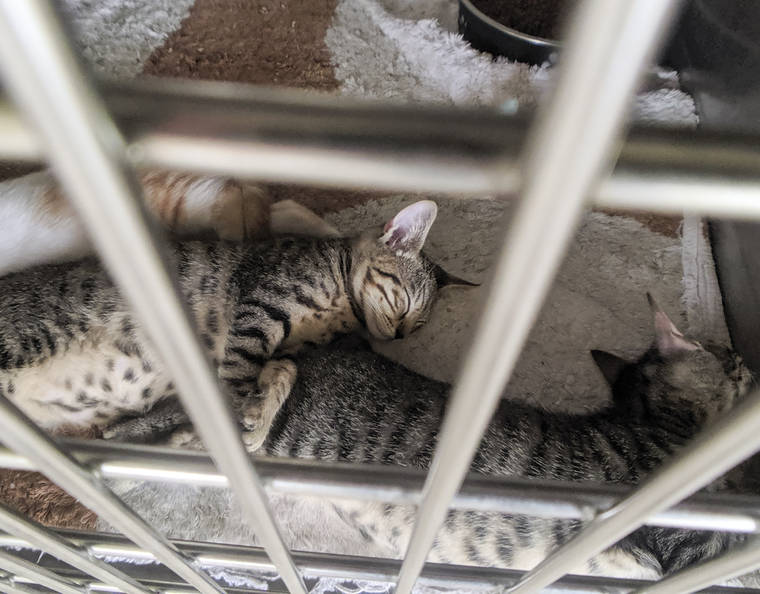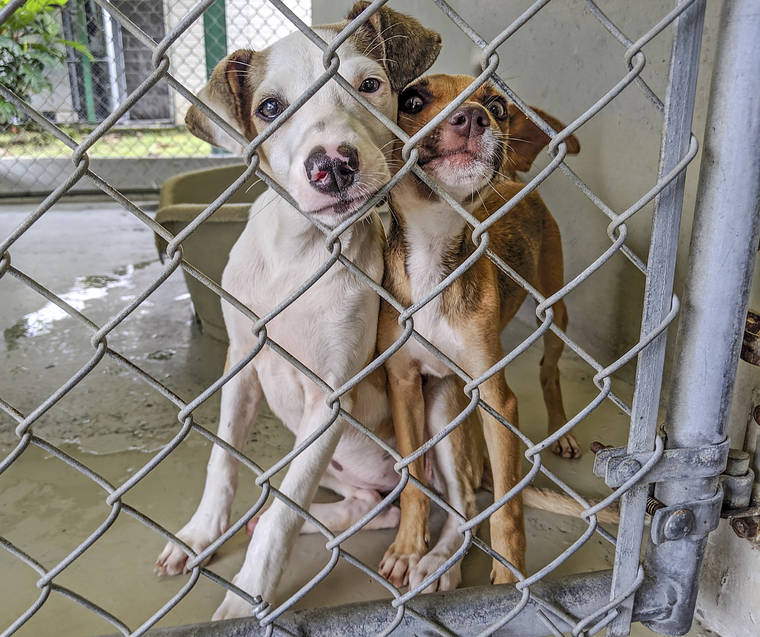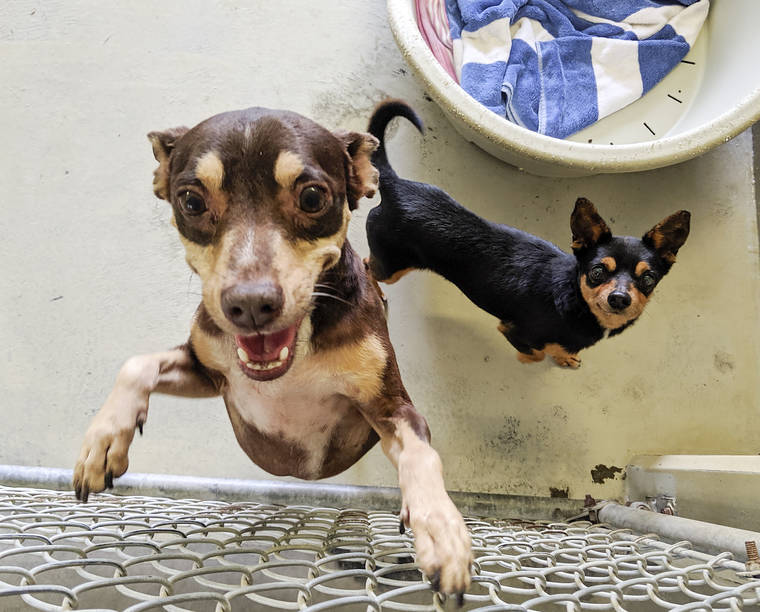A committee of five community members has submitted to the County Clerk a ballot initiative proposal seeking to establish an animal shelter standards law.
The proposal, sent by Deputy County Clerk Aaron Brown to County Council Chairman Aaron Chung on June 7, seeks to amend Chapter 4 of the Hawaii County Code by adding a new article regarding animal shelter standards to ensure impounded animals are protected from neglect and abuse, receive appropriate care and are given ample and reasonable opportunity for placement.
The measure, if placed on the ballot in 2020 and voted into law, would prohibit the euthanizing of a dog for 11 business days from impoundment and other animals for five business days, excluding animals that are irremediably suffering.
The ballot question, as submitted, reads: Shall the Hawaii County Code be amended to add regulations for animal shelters that would establish:
(1) Holding periods for the euthanasia and relocation of sheltered animals;
(2) Conditions under which an animal may be euthanized;
(3) Criteria for the custody of animals with regards for nutrition, hydration, exercise, sanitary living conditions, and medical services;
(4) Methods to identify and notify owners of impounded animals; and
(5) Procedures for the handling of community cats.
Ana Kahoopii and Maya Dolema, two longtime animal rescue workers, have been working on what Kahoopii called “a strategic plan for the animal control contract” since 2017. They and three others comprise the committee behind the ballot initiative. The proposal would have to go through a petition process requiring the signatures of registered voters numbering at least
15% of the total that voted for the office of mayor in the last mayoral election.
“We have one of the highest kill rates nationally. And there are many things that can be done that aren’t going to add any financial burden to the humane society,” Kahoopii said. “But that’s not the only thing. There’s the issue of how the spay/neuter funds are distributed and spent and … that circles us back to the strategic plan. We had a team of experts come in and review our island and teach us how to create high-volume spay/neuter clinics. And we got a lot of data from that, so we know, pretty much, how many spay/neuters we have to do in our community over three years to get our (animal) population to a sustainable level.”
The county contracts with the Hawaii Island Humane Society to provide for animal control services. Animal control services include operating shelters in Keaau, Waimea and Kona and the disposition of animals including euthanasia procedures, animal control officers, patrol and dispatch services, licensing and assistance with animal cruelty cases.
The contract for the past three fiscal years beginning July 1 and ending June 30 paid the humane society $2.081 million per year. The current contract beginning July 1 ends on Sept. 30 and is for $520,408.
HIHS has a new executive director, Charles Brown, coming aboard early next month. Brown has experience overseeing shelter operations in Indiana, Tennessee and Maryland. He replaces Donna Whitaker, who “stepped down” Nov. 19 after nearly a decade at the helm. Her departure came after questions and criticism at the County Council for at least three years concerning kill rates at the society’s shelters.
Board Chairman Adam Atwood has taken on executive director duties in the interim.
Atwood said neither he nor the nine-member board has seen the ballot initiative and they haven’t had any contact with the authors of the ballot initiative, but said HIHS “has proper procedures in place consistent with national shelter standards and best practices.”
“The Hawaii Island Humane Society opposes placing any specific veterinarian-related issues on a ballot as the organization believes strongly that experienced and licensed veterinarians on the ground are clearly in the best position to make such decisions,” said Atwood.
Between July 1, 2016 and April 30, 2019 — the last month the Tribune-Herald has statistics for — the Keaau shelter has euthanized 3,759 dogs, 6,952 cats and 1,471 unspecified “other” animals, according to shelter reports available on the Hawaii Police Department website. The Kona shelter euthanized 653 dogs, 1,628 cats and 2,721 “others.” The Waimea euthanasia numbers were 1,180 dogs, 977 cats and 141 “others.”
The combined yearly totals of euthanized animals the Tribune-Herald counted by adding the numbers differs from the totals provided by HIHS on the spreadsheet report.
For the fiscal year ending June 30, 2017, HIHS reported 7,562 animals euthanized while the Tribune-Herald’s count for that period is 7,374. The humane society reported 12,416 animals received during that period. Using the Tribune-Herald’s count, that comes out to a 59.4% kill rate, while HIHS’s count results in a kill rate of 60.9%.
For the fiscal year ending June 30, 2018, HIHS reported 6,343 animals euthanized, with the Tribune-Herald’s count yielding a number of 6,883. The humane society reported 10,851 animals received during that period. The Tribune-Herald’s figure results in a 63.4% kill rate, while HIHS’s numbers come out to a 58.4% kill rate.
For the period between July 31, 2018, and April 30, 2019, HIHS reported 5,801 animals euthanized with the Tribune-Herald counting 5,225. The humane society reported 7,727 animals received during that period. The Tribune-Herald’s count comes out to a 67.6% kill rate, with HIHS’s number resulting in a kill rate of slightly more than 75%.
Asked about apparent discrepancies in the numbers on the shelter reports, Atwood said Brown “will review the intake counts and categories for the various fiscal years you queried about upon his arrival … .”
Kahoopii noted “a lot of issues with how they do the reporting … even where they give themselves 100 percent adoption for adoptable animals.”
Total adoption numbers for the three shelters are 3,531 for the fiscal year ending June 30, 2017, 3,151 for the fiscal year ending June 30, 2018, and 2,661 between July 1, 2018 and June 30, 2019. Redemptions, meaning animals reunited with owners, totalled 992, 840 and 930, respectively, for those periods.
The shelter reports indicate no adoptable animals destroyed, a claim also touted on the HIHS website.
“Hawaii Island Humane Society recently hired the nationally known firm Humane Logic to provide an overview and assessment of all operations including policies, procedures and protocols for animal evaluation and euthanasia practices to insure that the organization is following nationally recognized best practices and procedures,” Atwood said.
He noted the shelters have limited space and take in feral cats, chickens, mongoose and other animals, accounting for kill rates.
Hawaii state law requires shelters to hold dogs that are licensed for nine days and unlicensed dogs for 48 hours before the animal is “sold” or “humanely destroyed.” Atwood said HIHS holds microchipped dogs for 10 days and dogs without microchips for 48 hours “before becoming eligible for adoption.”
“This timeframe allows for an adequate time for owners to be reunited with their pets and animals,” he said. “… While holding periods vary from state to state, the Hawaii Island Humane Society’s mandated holding periods are designated in its contract with the County of Hawaii.”
The law doesn’t specify a holding period for cats and Atwood didn’t answer a specific question concerning it, but noted the state “recently added feral cats to the invasive species list.”
“According to the Hawaii Invasive Species Council, feral cats (what the draft ballot question is calling community cats) contribute to widespread ecological disruptions that threaten native Hawaiian wildlife,” he said. “Feral cats are one of the most devastating predators of Hawaii’s unique wildlife. They also spread a potentially lethal parasite (Toxoplasma gondii) that contaminates terrestrial, freshwater, and marine environments and has been shown to negatively impact birds and mammals — including humans.”
Atwood said the current county contract has been in place for five years and one of Brown’s first tasks will be to renegotiate it.
Kahoopii said she’d like any future deals to include improvements in public reporting, a greater emphasis on spaying and neutering and increased oversight of how HIHS conducts publicly funded business.
“I think it’s time for us to join the rest of the nation,” she said. “There’s not a reason we have to keep doing things the way we did them 30 years ago, 40 years ago, 50 years ago. And I’d like to know why the humane society has been allowed to perform in the manner that they have without any oversight.”
Email John Burnett at jburnett@hawaiitribune-herald.com.











